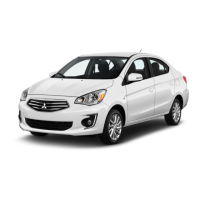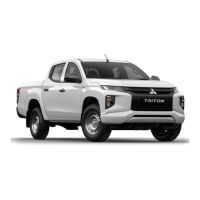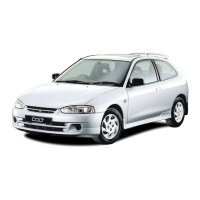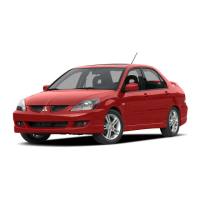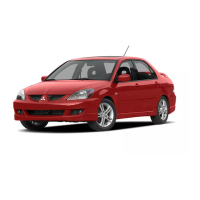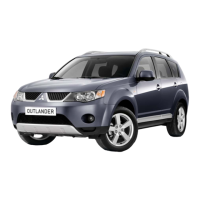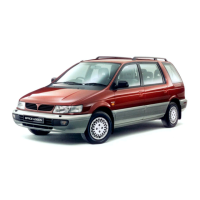
Do you have a question about the Mitsubishi MOTORS MIRAGE G4 2021 and is the answer not in the manual?
| Brand | Mitsubishi MOTORS |
|---|---|
| Model | MIRAGE G4 2021 |
| Category | Automobile |
| Language | English |
Details the location and function of the instrument cluster.
Explains the buttons and levers on the steering wheel for various functions.
Details controls located on the center console, including vents and audio.
Operation of power windows and lock switch for driver's door.
Overview of seat belts, airbags, and child restraint system anchors.
Details dome lights, vanity mirrors, and assist grips.
Identifies the spare tire, tools, and trunk room light in the luggage area.
Details sensors, wipers, lights, and keyless entry system components.
Distinguishes between Halogen and LED headlight types and their components.
Identifies rear lights, camera, antenna, and trunk lid open switch.
Explains warning lights, their meaning, and recommended actions.
Provides solutions for common vehicle problems and their reference pages.
Guidance on fuel types, octane requirements, and handling precautions.
Step-by-step instructions for filling the fuel tank and safety warnings.
Information on modifications, racing, and warranty coverage.
Importance of using genuine parts and consulting dealers for accessories.
Explanation of the EDR's purpose and data recording capabilities.
Instructions for adjusting front seats forward/backward, seatbacks, and height.
How to operate heated seats and important usage notes.
Details on rear arm rest, trunk-through lid, and head restraints.
Proper installation, removal, and usage of seat belts and guide straps.
Explanation of driver and front passenger seat belt reminder lights and tones.
Information on SRS warning lights, force limiters, and child restraint system usage.
Details the components of the SRS and how the system works.
Explains driver and passenger seat sensors and their impact on airbag deployment.
Explains the function and conditions for the passenger airbag off indicator.
Information on the SRS warning light and potential system malfunctions.
Conditions under which front airbags and knee airbags deploy or may not deploy.
Details on side and curtain airbag systems and their deployment conditions.
Guidance for the initial break-in period and information about vehicle keys.
Explanation of the anti-theft starting system and key programming.
How to use the keyless entry system, panic alarm, and answerback functions.
Operation, range, and programming of the F.A.S.T.-key system.
Operation of power door locks via switch, selector lever, and reminder systems.
How to operate child safety locks for rear doors and trunk lid.
Operation of power windows via main switch, sub-switches, and safety mechanisms.
Instructions on how to apply and release the parking brake.
Guidance on adjusting the steering wheel height and deactivating it.
Instructions for adjusting inside and outside rearview mirrors.
Operation of the ignition switch and folding the side mirrors.
Procedures for starting and stopping the engine, including troubleshooting.
Guidance on operating the manual transaxle, including shift points.
Driving precautions, speed limits, selector lever operation, and malfunction indicators.
Information on brake pedal, power brakes, and warning indicators.
Explanation of the hill start assist function and its operation.
Details on the brake assist system, warning indicators, and precautions.
Explanation of ABS, driving hints, and warning lights.
Information on the EPS system, warning lights, and after-driving procedures.
Explanation of ASC, traction control, skid control, and ASC OFF switch.
Operation, switches, activation, and deactivation of cruise control.
System overview, warnings, braking functions, and sensor handling.
Operation, warnings, and deactivation of the Lane Departure Warning system.
TPMS operation, warning lights, and malfunction indicators.
Location, screen reference lines, and operating precautions for the rear-view camera.
Details on the speedometer, tachometer, and multi-information display.
Explanation of information display, odometer, trip odometer, and dimmer control.
Information on driving range, average fuel consumption, and outside temperature display.
Indicators for frozen roads, fuel level, and fuel remaining warnings.
How to view and reset the service reminder for periodic inspections.
How to change function settings and reset modes for fuel consumption display.
Instructions for changing fuel consumption and distance units.
How to switch temperature display units between Fahrenheit and Celsius.
Overview of all indicators and warning lights in the instrument cluster.
Details on high beam, ECO, turn signal, and brake warning lights.
Explanation of the 'SERVICE ENGINE SOON' and charging system warning lights.
Information on oil pressure, high coolant temperature, and door-ajar warnings.
Operation of headlights, fog lights, and dimmer switch.
Functions of light auto-cutout and headlight reminder buzzer.
How to change headlight beams and use the Automatic High Beam system.
Manual control of headlights and automatic switching conditions.
Operation of the turn signal lever and hazard warning flasher switch.
Operation of front fog lights and windshield wipers/washers.
Operation of the rear window defogger, horn switch, and Link System.
How to connect USB devices, iPods, or smartphones to the vehicle's system.
Adjusting sun visors for glare and features of the vanity mirror.
Details on ticket holder, 12V power outlets, and interior lights.
Information on interior lights, auto cut-out function, and storage space cautions.
Location and usage of cup holders and the glove compartment.
Features for holding bottles, convenience hook, and assist grips.
Tips for improving fuel economy and recommendations for safe driving.
Proper installation of floor mats to avoid pedal interference and ensure safety.
Checks before driving, seat belt usage, and defroster operation.
Guidance on tires, lights, fluid leaks, defensive driving, and cold weather preparation.
Information on braking in wet conditions, cold weather, downhill, and parking.
Guidelines for vehicle loading, capacity weight, and load limits.
Rules for loading cargo, luggage, and roof loads to ensure safety.
Warning against using the vehicle for trailer towing due to control and braking issues.
Details on operating vents, air flow direction, and center/side vent controls.
Overview of the control panel, temperature, and blower speed adjustments.
How to change air flow direction using MODE and defogger switches.
Customizing air control, selection, and temperature settings for personal preference.
Operating tips for the air conditioning system, including defrosting and refrigerant information.
Information on the air filter, its maintenance, and antenna installation/removal.
Factors affecting radio reception, including signal transmission and disturbances.
Steps to take when the vehicle breaks down or the engine stops/fails.
Detailed instructions and safety precautions for jump-starting a vehicle.
What to do if the engine overheats, including checking coolant and fans.
Location and storage of the vehicle's jack and tools.
Step-by-step guide on how to change a flat tire, including spare tire information.
Guidelines for towing the vehicle, including warnings and proper methods.
Advice for driving in snow, mud, sand, wet, bumpy, or icy conditions.
Explanation of the fuel pump shut-off system's function after a collision.
General safety precautions for vehicle maintenance and servicing.
Proper usage of unleaded fuel and precautions to prevent catalytic converter damage.
Instructions on how to open, close, and secure the engine hood.
Identification of key components in the engine compartment and oil level check.
Guidance on engine oil types, viscosity, and oil filter replacement.
Checking coolant level, adding coolant, and replacing the oil filter.
Maintenance of the air cleaner filter and radiator cap.
Information on manual transaxle oil, CVT fluid, and washer fluid.
Checking brake fluid level, fluid type, and handling precautions.
Checking battery electrolyte, cold weather care, and disconnection/connection procedures.
Details on tire grades, pressure, markings, and replacement advice.
Checking and adjusting clutch and brake pedal free play.
Checking parking brake lever stroke and cleaning/replacing wiper blades.
Ensuring the emission control system works properly through regular inspection.
Checks for spark plugs, fuel hoses, valve clearance, and exhaust system.
Tips for ventilation, weatherstripping, and carrying winter equipment.
Fuse load capacities, location tables, and replacement procedures.
Procedures for replacing various exterior and interior light bulbs.
Information on tire grading and reporting safety defects to NHTSA.
Contact information for reporting defects and important facts after an accident.
Information on vehicle design, consumer rights, and using genuine parts.
Location of chassis number, emission control label, and VIN plate.
Key vehicle dimensions and location of the certification label.
Details on Gross Vehicle Weight Rating (GVWR) and seating capacity.
Engine model, displacement, spark plugs, battery, and tire/wheel specifications.
Table of capacities and recommended lubricants for various vehicle fluids.
Step-by-step process to calculate gasoline mileage using fuel tank and odometer readings.



